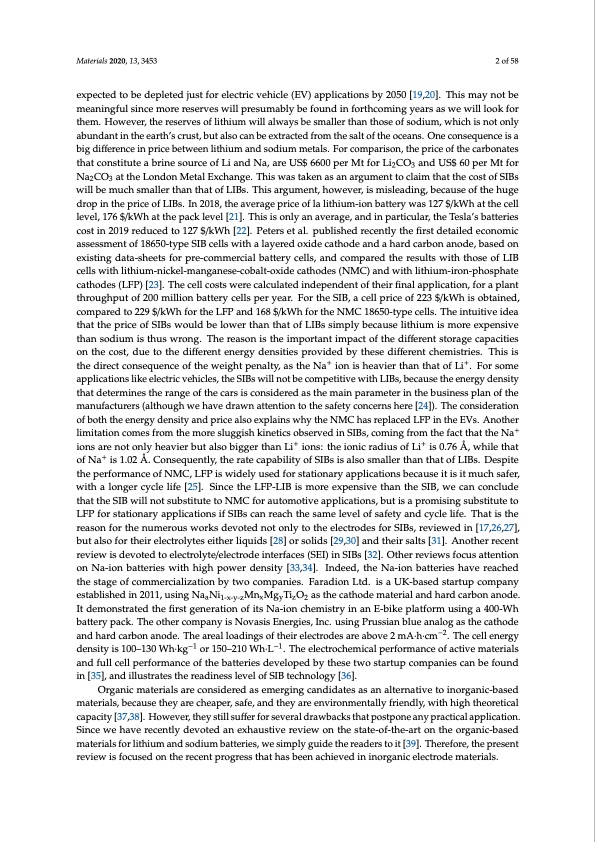
PDF Publication Title:
Text from PDF Page: 002
Materials 2020, 13, 3453 2 of 58 expected to be depleted just for electric vehicle (EV) applications by 2050 [19,20]. This may not be meaningful since more reserves will presumably be found in forthcoming years as we will look for them. However, the reserves of lithium will always be smaller than those of sodium, which is not only abundant in the earth’s crust, but also can be extracted from the salt of the oceans. One consequence is a big difference in price between lithium and sodium metals. For comparison, the price of the carbonates that constitute a brine source of Li and Na, are US$ 6600 per Mt for Li2CO3 and US$ 60 per Mt for Na2CO3 at the London Metal Exchange. This was taken as an argument to claim that the cost of SIBs will be much smaller than that of LIBs. This argument, however, is misleading, because of the huge drop in the price of LIBs. In 2018, the average price of la lithium-ion battery was 127 $/kWh at the cell level, 176 $/kWh at the pack level [21]. This is only an average, and in particular, the Tesla’s batteries cost in 2019 reduced to 127 $/kWh [22]. Peters et al. published recently the first detailed economic assessment of 18650-type SIB cells with a layered oxide cathode and a hard carbon anode, based on existing data-sheets for pre-commercial battery cells, and compared the results with those of LIB cells with lithium-nickel-manganese-cobalt-oxide cathodes (NMC) and with lithium-iron-phosphate cathodes (LFP) [23]. The cell costs were calculated independent of their final application, for a plant throughput of 200 million battery cells per year. For the SIB, a cell price of 223 $/kWh is obtained, compared to 229 $/kWh for the LFP and 168 $/kWh for the NMC 18650-type cells. The intuitive idea that the price of SIBs would be lower than that of LIBs simply because lithium is more expensive than sodium is thus wrong. The reason is the important impact of the different storage capacities on the cost, due to the different energy densities provided by these different chemistries. This is the direct consequence of the weight penalty, as the Na+ ion is heavier than that of Li+. For some applications like electric vehicles, the SIBs will not be competitive with LIBs, because the energy density that determines the range of the cars is considered as the main parameter in the business plan of the manufacturers (although we have drawn attention to the safety concerns here [24]). The consideration of both the energy density and price also explains why the NMC has replaced LFP in the EVs. Another limitation comes from the more sluggish kinetics observed in SIBs, coming from the fact that the Na+ ions are not only heavier but also bigger than Li+ ions: the ionic radius of Li+ is 0.76 Å, while that of Na+ is 1.02 Å. Consequently, the rate capability of SIBs is also smaller than that of LIBs. Despite the performance of NMC, LFP is widely used for stationary applications because it is it much safer, with a longer cycle life [25]. Since the LFP-LIB is more expensive than the SIB, we can conclude that the SIB will not substitute to NMC for automotive applications, but is a promising substitute to LFP for stationary applications if SIBs can reach the same level of safety and cycle life. That is the reason for the numerous works devoted not only to the electrodes for SIBs, reviewed in [17,26,27], but also for their electrolytes either liquids [28] or solids [29,30] and their salts [31]. Another recent review is devoted to electrolyte/electrode interfaces (SEI) in SIBs [32]. Other reviews focus attention on Na-ion batteries with high power density [33,34]. Indeed, the Na-ion batteries have reached the stage of commercialization by two companies. Faradion Ltd. is a UK-based startup company established in 2011, using NaaNi1-x-y-zMnxMgyTizO2 as the cathode material and hard carbon anode. It demonstrated the first generation of its Na-ion chemistry in an E-bike platform using a 400-Wh battery pack. The other company is Novasis Energies, Inc. using Prussian blue analog as the cathode and hard carbon anode. The areal loadings of their electrodes are above 2 mA·h·cm−2. The cell energy density is 100–130 Wh·kg−1 or 150–210 Wh·L−1. The electrochemical performance of active materials and full cell performance of the batteries developed by these two startup companies can be found in [35], and illustrates the readiness level of SIB technology [36]. Organic materials are considered as emerging candidates as an alternative to inorganic-based materials, because they are cheaper, safe, and they are environmentally friendly, with high theoretical capacity [37,38]. However, they still suffer for several drawbacks that postpone any practical application. Since we have recently devoted an exhaustive review on the state-of-the-art on the organic-based materials for lithium and sodium batteries, we simply guide the readers to it [39]. Therefore, the present review is focused on the recent progress that has been achieved in inorganic electrode materials.PDF Image | Electrode Materials for Sodium-Ion Batteries

PDF Search Title:
Electrode Materials for Sodium-Ion BatteriesOriginal File Name Searched:
materials-13-03453-v2.pdfDIY PDF Search: Google It | Yahoo | Bing
Salgenx Redox Flow Battery Technology: Salt water flow battery technology with low cost and great energy density that can be used for power storage and thermal storage. Let us de-risk your production using our license. Our aqueous flow battery is less cost than Tesla Megapack and available faster. Redox flow battery. No membrane needed like with Vanadium, or Bromine. Salgenx flow battery
| CONTACT TEL: 608-238-6001 Email: greg@salgenx.com | RSS | AMP |